16 Types of Carrots to Invigorate Your Garden & Dishes
Author: Jen Worst | Editor: Omar Alonso
Review & Research: Jen Worst & Chris Miller
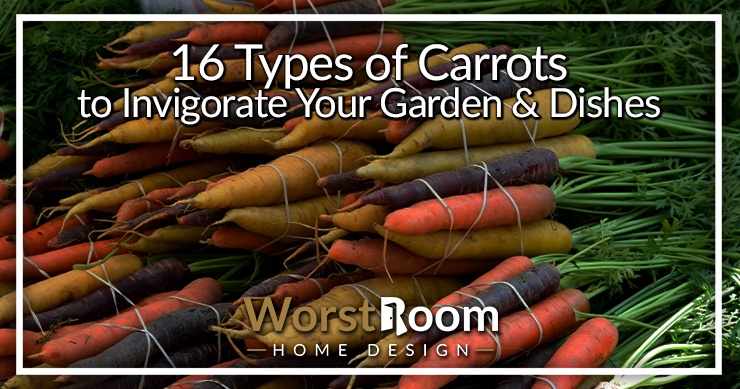
When we think of any types of carrots, the bright orange-colored ones come to mind because that's really all most of us know. But that's not the only color as you'll see below.
This nutrition-rich and delicious vegetable is used in dishes all around the globe. Hence, they are also grown all over the world.
But did you know that there are many different types of carrots that fall under 5 broad categories? That's our topic of discussion today.
In this article, you'll get to learn about many new kinds of carrots you haven’t seen before. We can't cover every little hybrid or variation, but we'll touch all the major (and interesting) bases for you. Let’s begin!
16 Types of Carrots
Carrots are so far thought to have been domesticated as far as 5,000 years ago. We've found carrot seeds in dig sites in Germany and Switzerland dating back that far. The first documented cultivated carrots themselves were 1,100 years ago in Central Asia (they were purple and yellow). Orange carrots first showed up in art in Europe in the 1500's.
The following 5 sections are the main broad categories carrots fall under, completed with subsections of common or cool varieties you will find under each broad category.
1) Danvers Carrots
This is the classic carrot everyone knows. Danvers are skinny, long, and have a pointed end. They get their name from their place of development, Danvers, Massachusetts.
Generally, these carrots are medium in size and orange in color. But other colors are seen as well.
Danvers will make a good starting point if you are a beginner just getting started with growing carrots.
They are easy to grow and more tolerant to shallow and heavy soil. These carrots have longer taproot and foliage compared to the other kinds.
Danvers grow about 6 to 7 inches long. They are well known for their almost coreless roots, deep orange tone, and fantastic flavor. Other than the classic orange Danvers, another type of Danvers is...
Solar Yellow Carrot
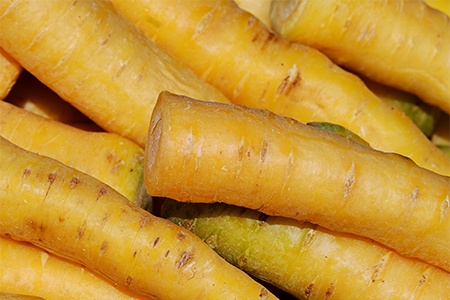
As you can guess from the name, these types of carrots are yellow. They are a hybrid of orange and yellow carrots – producing the bright orange-yellow shade.
These varieties of carrots are an old variety and a perfect example of heirloom. Their bright sunny shade will bring a touch of joy to any dish.
These carrot types are extra sweet and would be perfect in stir-fries and salads. Because of the sweetness, they make great juice, too, using most types of juicers. Some people even make tasty yet healthier types of french fries out of them.
2) Nantes Carrots
Much like the previous kind, Nantes are also easy-to-grow carrot varieties. Their color varies from bright orange to reddish-orange.
You can also eat the greens of these carrots. These carrots are sweet and crisp, but you may also get a grassy aftertaste from them.
Nantes are almost perfectly cylindrical; the entire body has the same diameter, ending in blunt tips. They are practically coreless.
Nantes grow the best in rocky and heavy soils. Because they have very little core, they are not prone to produce pithy cores if left to grow too much.
Nantes are great for eating fresh or making juice. These kinds of carrots might be too soft or delicate for commercial production, so home gardeners mainly produce them. They have over 40 different varieties in the market, a few of which are...
Scarlet Nantes Carrot
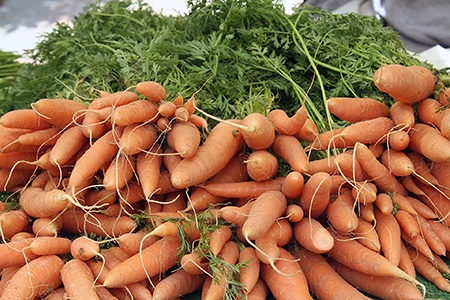
Scarlet Nantes is the most popular as well as the oldest variety of Nantes. They grow to be 6 to 8 inches long in most any types of gardens.
You can also harvest them early as baby carrots if you desired. They are perfect for eating fresh and juicing. These carrots store and freeze well, too.
Bolero Carrot
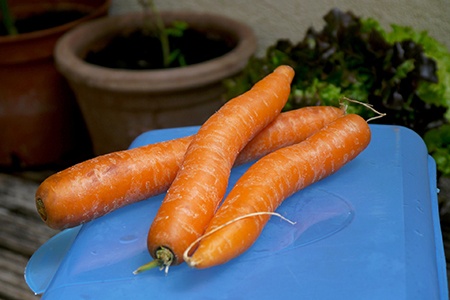
This is a high-yielding Nantes variety perfect for storing through preserves, canning, freezing, etc. It matures in 75 days and grows in an even, cylindrical shape.
Cosmic Purple Carrot
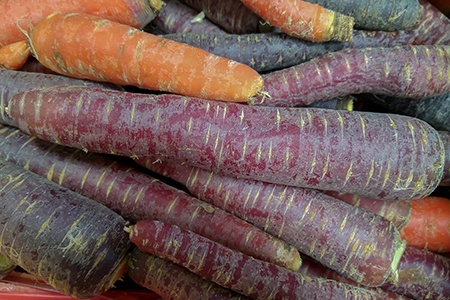
This is a very well-known purple-colored carrot variety. In reality, only the skin of these carrots is purple. Once you cut in, you will find the typical orange flesh inside.
The purple skin provides anthocyanin, which is a type of antioxidant. These carrots have a slight hint of spice in them. They retain the purple hue even after being cooked.
Nelson Carrot
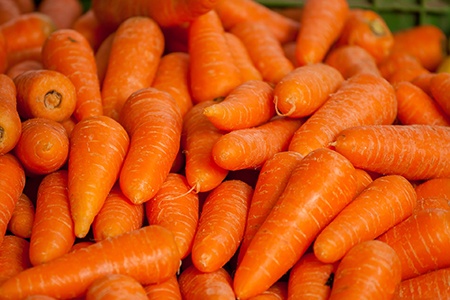
These are uniform, deep orange types of carrots that are sweet. They're one of the older variants of Nantes. It takes around 58 days to mature and reaches approximately 7 inches during that time.
White Satin Carrot
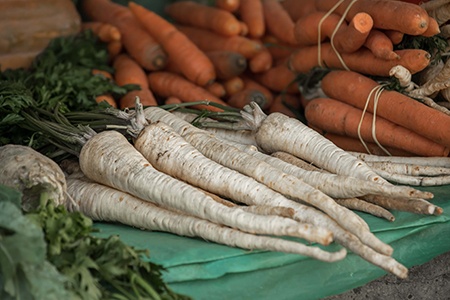
These different kinds of carrots are entirely white. They are a cross between Nantes and Imperator, which gives them a shape like Danvers.
They are often added to rainbow mix carrots for their color. They mature in about 70 days. These carrots are crisp and juicy.
Purple Dragon Carrot
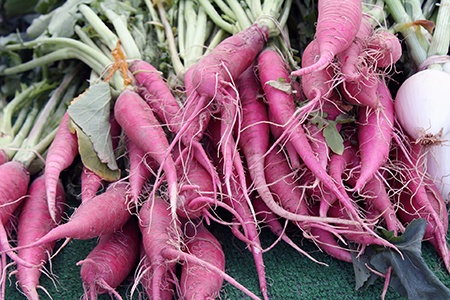
Bright orange on the inside and dark purple on the outside, these carrots lose their iconic purple color when cooked.
They are like a throwback to how carrots originally were, which is purple. These carrots are incredibly nutritious, packed with phytochemicals.
Yaya Carrot
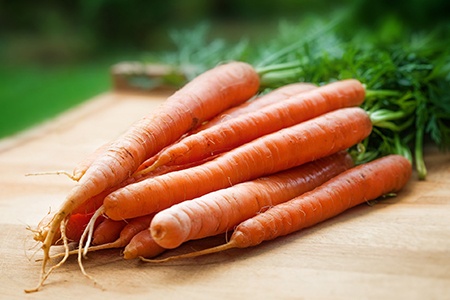
These are very similar Nelson carrots. They are perfect for sowing during fall because they hold up well in the ground. It takes about 60 days for them to be ready for harvest.
3) Imperator Carrots
Imperators are the most commercially grown carrots. Hence, these are the types of carrots you see when you go grocery shopping. They have the classic carrot shape we are used to seeing – long, pointed, and tapered.
The difference between Danvers and Imperators is the former is narrower in width and less sweet. Imperator carrot foliage grows very fast.
Their roots get very long, too, up to 10 inches. Because of the high sugar content, Imperator carrots are delightful for fresh eating.
For Imperator carrots, the best type of soil is deep, sandy, and loose. Do not go for them if you have rocky or heavy soil. Imperator carrots store very well, too. Here are a few common types of Imperator carrots...
Autumn King Carrot
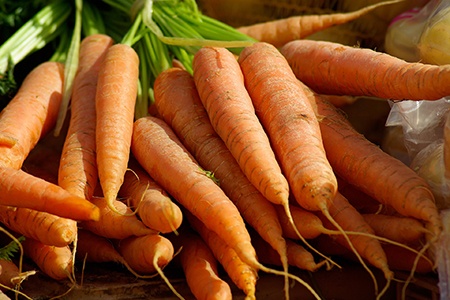
This is a very long, 10 to 12 inch long Imperator carrot. They mature in about 70 days. This carrot is very hardy and tasty. It tolerates cold well.
Atomic Red Carrot
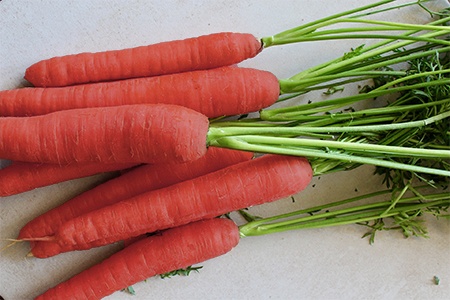
These kinds of carrot have a rich, vibrant red exterior and bright orange flesh. It is slim and long, with up to 11-inch height. The red color stays even when you cook them. They are best eaten cooked or roasted.
Candysnax Carrot
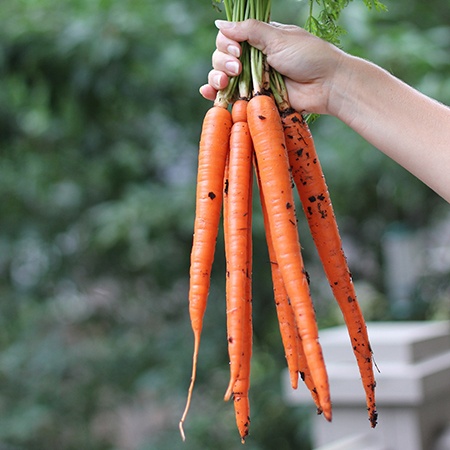
As you can guess from the name, these carrots are like nature’s candy. They are very sweet and crunchy and wonderful to snack on. These carrots mature in about 65 days.
4) Chantenay Carrots
Chantenay carrots are the opposite of Imperator carrots – they are short and stubby. Like Danvers, they get their name from their native region, too, which is Chantenay, France. Their shape is conical, with bulky shoulders and a tapered blunt tip.
Before Nantes carrots were created, Chantenay was the only kinds of carrots that could grow in rocky, heavy soil.
In fact, their shape is stout and small because of the type of soil they grow in. Generally, these types of carrots reach up to 6 - 7 inches in length.
If you are gardening in small containers, then consider growing Chantenays. However, make sure to harvest them when they reach the 6 – 7 inch mark. You can do it at scale with backyard farming as well, so don't hesitate.
If they grow past that, the core gets woody and tough to eat. It takes about 79 days for these carrots to mature. A few common types of Chantenay are...
Red-Cored Chantenay Carrot
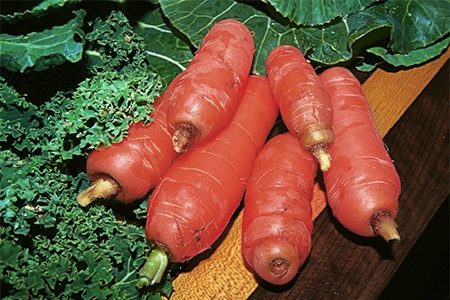
These are deep-orange Chantenays originating from France. They are about 7 inches long and take 70 days to mature. You can increase their sweetness by storing them for long periods.
Hercules Carrot
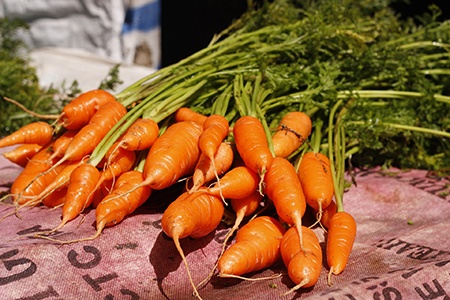
These carrot varieties thrives in any soil – even where other carrots wilt. They're suitable for rocky, heavy, or clay soils. These carrots have broad shoulders. They mature in around 65 days.
Kuroda Carrot
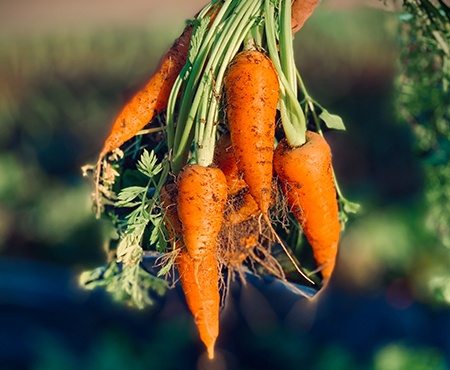
Kuroda carrots are very large and weighty. Each carrot can easily weigh half a pound. They reach about 8 inches in length and 2 inches in width.
These carrot types are grown in sub-tropic areas and are tolerant of blight and high temperatures.
5) Mini or Ball Carrots
If you thought Chantenays are the miniature varieties of carrots, think again. These carrots grow only about 3 to 4 inches tall. Because they are so small, they grow pretty fast, giving you instant gratification. They have a shape similar to many types of radishes.
Minis are the best type of carrots to grow in containers because of their size. They grow well in heavy soils, so make sure to get some if you plan on getting mini carrots.
You can also find round mini carrots to add a fun element to your salads. Two popular mini carrot types are...
Romeo Carrot
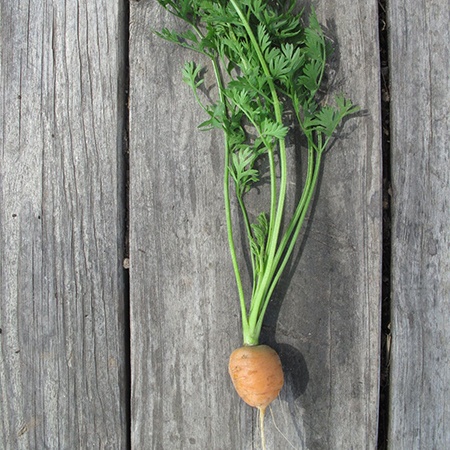
These are super cute spherical and tiny carrots shaped like radish or small types of beets. Romeos grow 1 to 2 inches long. They have a beautiful cross-section.
You don’t have to peel or cut them; just wash them and toss them into your salad for a delightful crunch.
Babette Carrot
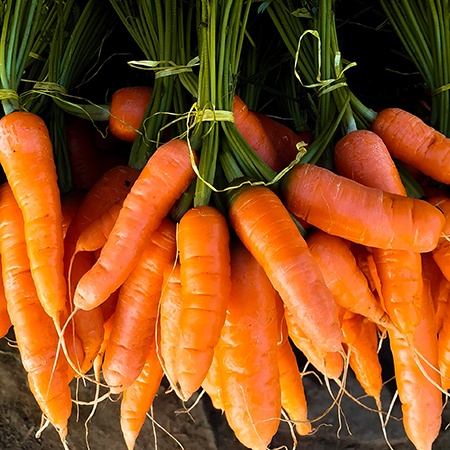
These are cylindrical and blunt-tipped. They grow about 3 to 4 inches long. It is of great quality and full of flavor, often served whole in high-end restaurants.
Types of Carrots for Every Garden
Trying out different types of carrots is worth the trouble - you get to try the differences in taste, sweetness, color, and texture among them. Be adventurous and you may find your new favorite.



